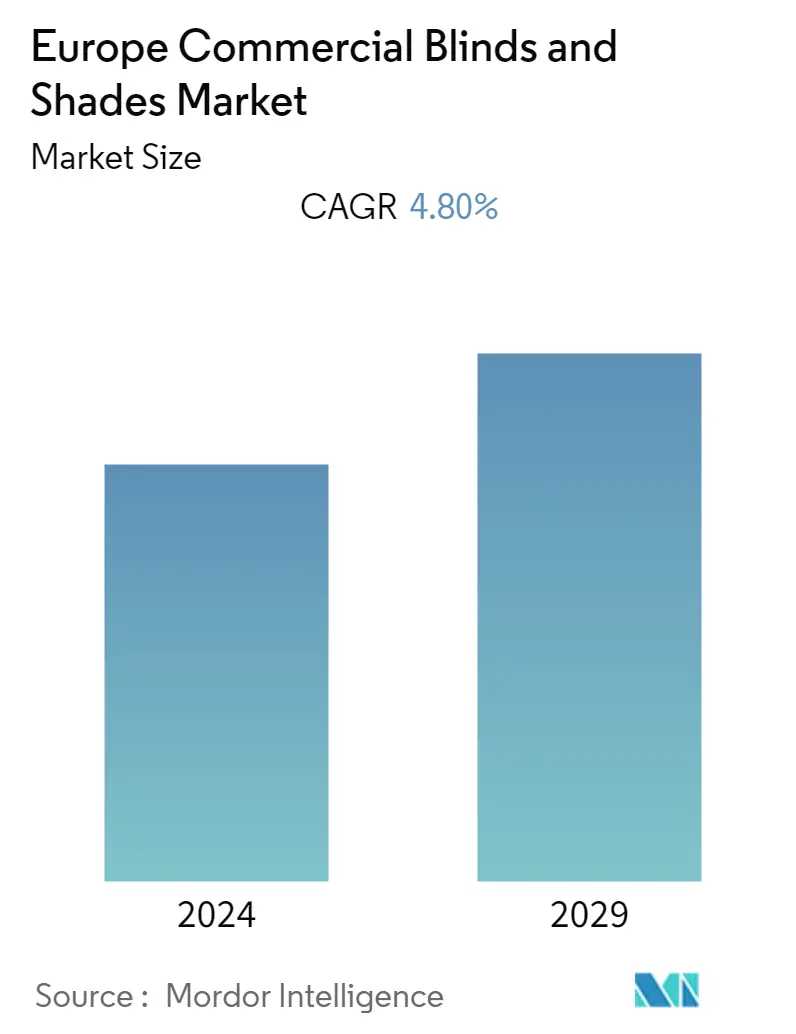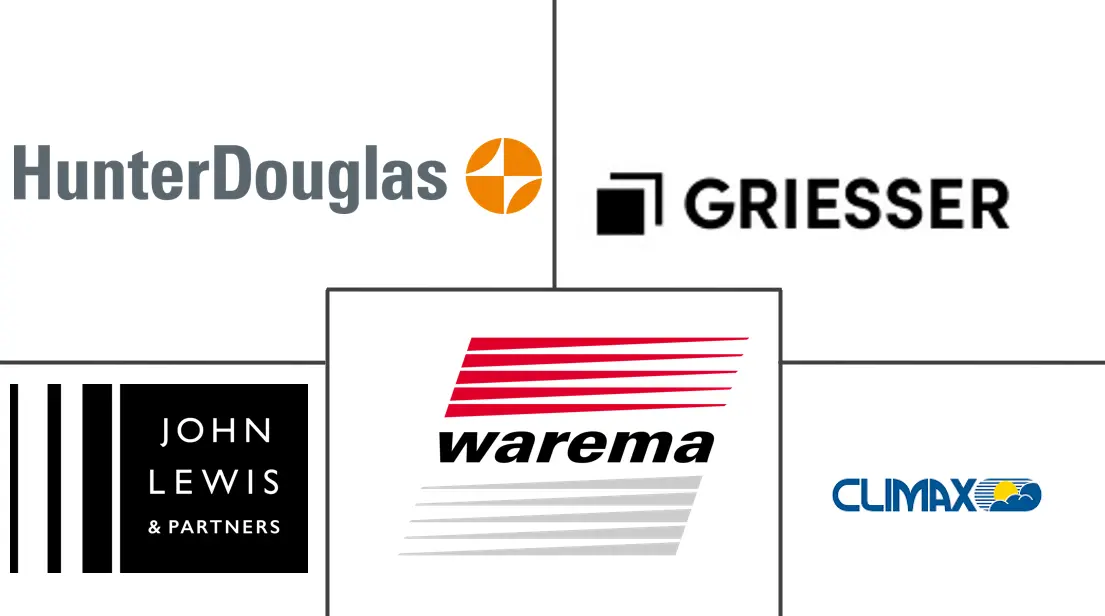Market Size of Europe Commercial Blinds and Shades Industry

| Study Period | 2019 - 2029 |
| Base Year For Estimation | 2023 |
| Forecast Data Period | 2024 - 2029 |
| Historical Data Period | 2019 - 2022 |
| CAGR | 4.80 % |
| Market Concentration | Low |
Major Players
*Disclaimer: Major Players sorted in no particular order |
Europe Commercial Blinds & Shades Market Analysis
The Europe Commercial Blinds and Shades Market is expected to register a CAGR of 4.8 % during the forecast period of 2022 - 2027. The coronavirus outbreak (COVID-19) was a massive restraint on the commercial blinds and Shades manufacturing market in 2020, as supply chains were disrupted due to trade restrictions and consumption declined due to lockdowns imposed by governments in Europe. Steps by national governments to contain the transmission have resulted in the halting of manufacturing activities and a decline in economic activity, with countries entering a state of lockdown. The outbreak was expected to have a negative impact on businesses throughout 2020 and into 2021.
- In recent years, the real estate industry has experienced considerable growth and increased the value of residential properties. The demand for window coverings develops in parallel with the number of commercial buildings, raising the price of window blinds. Consumer spending is also an important factor in the window blind industry. The rise of the window blind market has also been influenced by brand awareness and television advertisements.
- Material, quality, and affordability are important considerations when choosing window blinds and shades. The window blinds industry is driven by increased commercial construction. The market for window blinds is expected to grow rapidly in the near future. The growth in smart commercial building popularity and infrastructure development throughout Europe will likely propel the market forward over the forecast period. The demand for window blinds is also being boosted by changes in the interior design of commercial buildings.
- The window blind slats can easily get damaged, especially if the blinds are made up of aluminum or plastic blinds. Lack of awareness about interior window treatment solutions among commercial consumers is likely to restrain the window blinds and shades market.
- Customers' demand for the latest technology-based goods is growing. Thus, window coverings providers are offering a wide of blinds and shades with innovative features and competitive prices. Smart building adoption is projected to continue strong because of technological developments and the addition of new features to industrial automation. Hence with rising in smart buildings, demand for portable window coverings is expected to increase rapidly over the forecast period.
Europe Commercial Blinds & Shades Industry Segmentation
Shades are a single solid window covering made of softer materials, whereas blinds are structural window coverings with slats that may be tilted open or closed. Blinds come in various materials, including wood, woven wood, bamboo, fake wood, aluminum, and vinyl, and can be horizontal or vertical.
The Europe Commercial Blinds and Shades Market is Segmented by Product Type (Blinds, Shades), Distribution Channel (Online, Offline), By Mechanism (Fully Automatic, Semi-Automatic), End-user (Retail, Hospitality, Leisure & Entertainment, Offices, Healthcare, Educational Institutions) and Geography.
| By Type | |
| Blinds (Venetian, Vertical, Roller, and Others) | |
| Shades (Roman, Pleated, and Roller) |
| By Distribution Channel | |
| Online | |
| Offline (Departmental Stores, Specialists, DIY, and Grocery Stores) |
| By Mechanism | |
| Fully Automatic | |
| Semi-Automatic |
| By End-user | |
| Retail | |
| Hospitality, Leisure & Entertainment | |
| Offices | |
| Healthcare | |
| Educational Institutions | |
| Others |
| By Country | |
| Germany | |
| France | |
| United Kingdom | |
| Rest of Europe |
Europe Commercial Blinds and Shades Market Size Summary
The Europe Commercial Blinds and Shades Market is poised for growth, driven by the increasing demand for window coverings in tandem with the rise in commercial construction and real estate development. The market experienced setbacks during the COVID-19 pandemic due to supply chain disruptions and decreased consumer spending, but it is expected to recover and expand. The popularity of smart commercial buildings and advancements in interior design are further propelling the market. Consumers are increasingly seeking innovative and technologically advanced window covering solutions, which are being offered at competitive prices by various providers. However, challenges such as the potential damage to window blind slats and a lack of awareness about interior window treatment solutions among commercial consumers may pose constraints to market growth.
The shift towards online shopping has significantly influenced consumer purchasing behavior in the commercial blinds and shades market. The convenience of online distribution channels, offering flexible payment methods and a wide variety of products, has attracted consumers to purchase window coverings online. This trend is supported by the ability to access user reviews, attractive discounts, and convenient return policies. In Germany, the market is expected to benefit from trendy and energy-saving window processing solutions, with a focus on smart and automated products. Key players like Hunter Douglas and WAREMA are actively expanding their product offerings and enhancing their market presence through collaborations and strategic initiatives. The market's competitive landscape is characterized by technological advancements and product innovations, enabling mid-size to smaller companies to secure new contracts and explore new markets.
Europe Commercial Blinds and Shades Market Size - Table of Contents
-
1. MARKET INSIGHTS
-
1.1 Market Overview
-
1.2 Industry Attractiveness - Porter's Five Forces Analysis
-
1.2.1 Bargaining Power of Suppliers
-
1.2.2 Bargaining Power of Consumers
-
1.2.3 Threat of New Entrants
-
1.2.4 Threat of Substitutes
-
1.2.5 Intensity of Competitive Rivalry
-
-
1.3 Value Chain Analysis
-
1.4 Assessment of the Impact of COVID-19 on the Industry
-
-
2. MARKET SEGMENTATION
-
2.1 By Type
-
2.1.1 Blinds (Venetian, Vertical, Roller, and Others)
-
2.1.2 Shades (Roman, Pleated, and Roller)
-
-
2.2 By Distribution Channel
-
2.2.1 Online
-
2.2.2 Offline (Departmental Stores, Specialists, DIY, and Grocery Stores)
-
-
2.3 By Mechanism
-
2.3.1 Fully Automatic
-
2.3.2 Semi-Automatic
-
-
2.4 By End-user
-
2.4.1 Retail
-
2.4.2 Hospitality, Leisure & Entertainment
-
2.4.3 Offices
-
2.4.4 Healthcare
-
2.4.5 Educational Institutions
-
2.4.6 Others
-
-
2.5 By Country
-
2.5.1 Germany
-
2.5.2 France
-
2.5.3 United Kingdom
-
2.5.4 Rest of Europe
-
-
Europe Commercial Blinds and Shades Market Size FAQs
What is the current Europe Commercial Blinds and Shades Market size?
The Europe Commercial Blinds and Shades Market is projected to register a CAGR of 4.80% during the forecast period (2024-2029)
Who are the key players in Europe Commercial Blinds and Shades Market?
Hunter Douglas, WAREMA Renkhoff SE, John Lewis plc, SERVIS CLIMAX, a.s. and Griesser AG are the major companies operating in the Europe Commercial Blinds and Shades Market.

